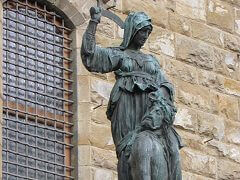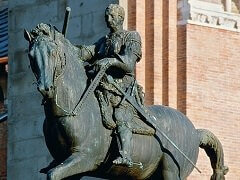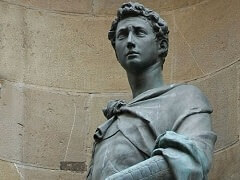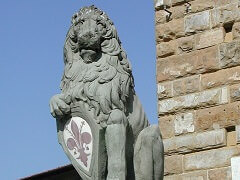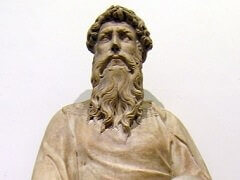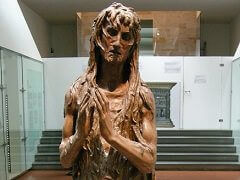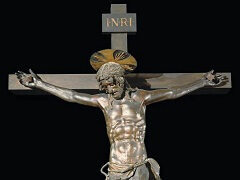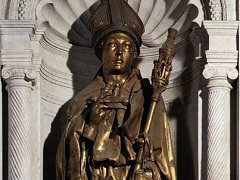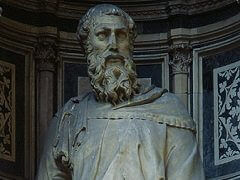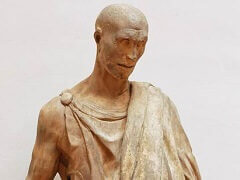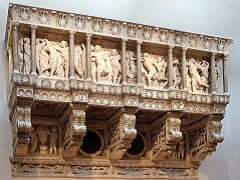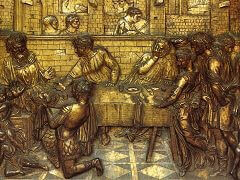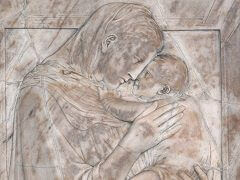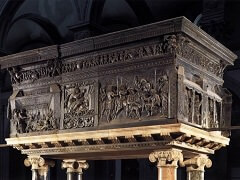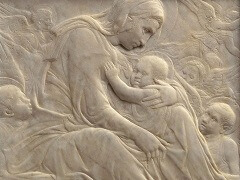Donatello Biography
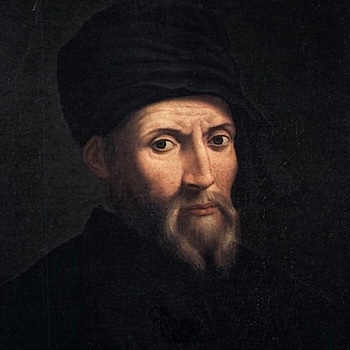
Donatello di Niccolo di Betto Bardi, better known as simply Donatello, is arguably one of the most influential sculptors from the Italian Renaissance. He was born in 1386 or 1387 in Florence, Italy. The exact date is unknown.
Donatello's father was Niccolo di Betto Bardi. The Bardi family were commercially successful and Niccolo Bardi was a wool carder that had earned a modest place in Florence's bourgeois society. This social rank likely earned Donatello an apprenticeship around 1400 to learn stone-carving with one of the many sculptors who worked nearby during the construction of the Florence's cathedral, the Duomo.
Between approximately 1404-1407 Donatello found employment as a member of Lorenzo Ghiberti's workshop. Ghiberti was well known for his International Gothic style of bronze sculpture and excelled at creating gracefully subtle lines in his work. Donatello's first statue depicting David is one of his earliest known works and in many respects pays homage to Ghiberti's style. Other early works include his marble St. John the Evangelist for the Duomo's facade and a crucifix made from wood for nearby Santa Croce's church.
As Donatello refined his skill as a sculptor he also gained a reputation as being somewhat emotionally volatile. It was reported anecdotally that he had a temper and an abrasive sense of humor. Very little is known about his personal life but stories recorded from his friend Vasari seem to indicate he was agnostic. This may account for his unique take on the religious iconography he was commonly commissioned to create.
Around 1415 Donatello's full range as an artist began to emerge in two marble statues completed in the same year. His statues of St. Mark and St. George show immense confidence and personality in everything from their attire to their facial expression. Both statues were carved from marble and also informed a series of statues of prophets that would later surround the bell tower of the Duomo. All of these depictions of the prophets are strikingly unique from medieval and ancient portraits of the prophets, with Zuccone being considered the finest and most masterful of the collection.
Donatello created his own form of relief in sculpted marble panels called "schiacciato." This translates in English as "flattened out." This technique allowed a far shallower carving that gave a sense of depth. The principal subjects of the panel appeared to pop off the sculpted work. He used this technique to great success in many works such as St. George Killing the Dragon and The Ascension, with Christ Giving the Keys to St. Peter.
During the same period of time in which he was developing his work within marble panels, Donatello had also become accomplished at casting figures in bronze. Around 1423 he completed his first major bronze work entitled St. Louise of Toulouse. Though the initial response was underwhelming, the work is now considered a great artistic achievement. Part of the reason for the poor reception initially may have been the difference in it's two locations and the surrounding materials. Originally installed as a part of a niche at Orsanmichele, in 1460 the statue was moved to Santa Croce. There the surrounding plaster background did not harmonize with the work to the same effect that the marble in the Orsanmichele niche appeared to.
It is speculated St. Louise of Toulouse may have been one of the first collaborations Donatello designed with Michelozzo. Michelozzo was a Florentine sculptor and architect who had also studied under Ghiberti. In the next few years they shared a limited partnership where Donatello constructed a sculptural centre for the bronze effigy of John XXII. He also contributed the relief work for the Assumption of the Virgin on the Brancacci tomb in Naples and the balustrade relief work surrounding the exterior pulpit of the Prato Cathedral.
While Donatello's solo work seems inspired by a wide variety of ancient art, his collaborations with Michelozzo are much more similar to works by Filippo Brunelleschi. As Donatello continued his solo career he expanded upon his own singular style of blending classical and medieval sources and in doing so stated through his work his preference to depart from old standards Brunelleschi had established. This created a rift between Brunelleschi and Donatello that persisted until their deaths.
Donatello's independent work during his period of collaboration with Michelozzo is considered some of his finest. Feast of Herod showed a command of linear perspective in Donatello's own relief technique. A series of small nude angels influenced by Etruscan art helped pave the way for Donatello's bronze David with the Head of Goliath. This spectacular work was cast sectionally in bronze and is an interpretation of a symbolic figure representing pride and the role of divine protection against evil forces. This bronze David may have been a commissioned work from the Medici family and originally was placed in the center of the Medici palace in Florence.
In the 1440s Donatello was invited to Padua to work on a series of bronze works. He first completed the Crucifix for the Padua santo. Arguably the most enticing of the commissions in Padua was the equestrian statue known popularly of as Gattamelata. This work depicts the Venetian Erasmo da Narmi atop his steed in battle regalia. Its popularity spread immediately after its completion when other nobles desired the same type of depiction.
While Donatello did take on a few more important commissions for the Church of San Antonio in Padua, he also seems to have gone through a personal crisis or illness in the small Venetian town. Work was stalled on various projects and though a series of majestic reliefs and the sculpture of Marble Madonna were completed, a Florentine physician recorded a statement that he had treated Donatello for an illness.
When Donatello returned to Florence his work had changed, reflecting perhaps his own realization of his mortality. Figures like his statue of Mary Magdalene revealed withered skin and an aging sensibility that seemed to reveal Donatello's perception of himself.
He spent his last years working on two bronze pulpits for the church of San Lorenzo. Though they displayed enormous spiritual complexity and mastery of his craft, Donatello did not complete these pieces before his death in 1466. A great deal of Donatello's work is still on display in Florence in the Museo dell'Opera del Duomo and in cathedrals and public spaces throughout Italy.
10 Interesting Facts About Donatello
1. Unlike many other celebrated artists of his day, Donatello did not spend his entire youth as a studio apprentice to a master. Instead, he studied briefly with a stone mason and a goldsmith. He then worked with Lorenzo Ghiberti on the bronze entry to Florence's Baptistery, which was later dubbed the Gates of Paradise by Michelangelo. At the tender age of 17, Donatello was out on his own, making a name for himself in Renaissance Florence.
2. The artist progressed during his life from humble beginnings as the son of a wool carder to a final resting place beside his lifelong supporter, Cosimo di Giovanni de' Medici, who was a wealthy banker, an art patron and the founder of the powerful Medici dynasty of Italy, de facto rulers of Florence during the artist's lifetime. The elder Medici had commissioned Donatello's best-known work, the bronze David, in 1430 as well as many other artworks. The men's remains are entombed side by side in Florence's Basilica of San Lorenzo.
3. Donatello popularized a unique manner of communicating motion in otherwise inanimate stone. The Italian name for this technique, which shows figures in energetic, spiraling poses, is "figura serpentinata." It is similar to but not the same as contrapposto, a type of pose also used by sculptors. Subsequent masters such as Leonardo da Vinci, Raphael and Michelangelo variously adopted both technique to breathe life into their sculptures.
4. Early in the 15th century, Donatello spent several years in Rome with fellow Florentine and goldsmith apprentice Filippo Brunelleschi where they excavated for relics and studied the city's ruins. This trip gave Donatello a reputation as a treasure seeker. He later worked again in Rome sculpting tombs with the artist/architect Michelozzo, whom he had met in Ghiberti's workshop.
5. In later life, the sculptor journeyed to Padua in the Republic of Venice where he completed a commission for a life-sized bronze statue of famed military leader Gattamelata on horseback. As the first publicly displayed, standalone bronze equestrian statue since ancient times, the sculpture represented a paradigm for future works of other Italian and European artists.
6. Donatello did not confine himself to stone and metal as media for his sculptures. He produced a carved wood statue, Penitent Magdalene, around 1450, for the Bapistery of Florence. The statue was groundbreaking in Renaissance Christian art for its realism and the unique vision of Mary Magdalene as one who is wasted away from fasting rather than healthy and beautiful as she appears in earlier art.
7. Despite being a celebrated artist of his day, Donatello was not generally well-liked as a person. He was known to destroy a sculpture sooner than allowing someone he didn't approve of to buy it. He highly valued his artistic freedom, and he earned a reputation in society for being abrasive. Under the protection of the Medici family, the artist did not have to worry about the repercussions of his antisocial behavior.
8. Contrary to today's conception of the starving artist, Donatello enjoyed fame, acclaim and financial success during his lifetime. While this is largely due to his own talent, artistic vision, and love of innovation, his close relationship with the Medici family didn't hurt, providing him with a reliable source of commissions.
9. Although Donatello's artistic influence was not confined to Florence, the vast majority of his surviving works remain in that city and in Rome. In fact, the single artwork by the early Renaissance master now on exhibit in the U.S. is his Marble Madonna, rendered in Donatello's signature rilievo schiacciato, or flat relief style, at the Boston Museum of Fine Arts.
10. Three primary factors that contributed to the fact that, as an artist in Florence around the beginning of the 15th century, Donatello was squarely situated in the cradle of the Renaissance. Not only did his prosperous home town have a wealthy merchant class, but it was a gathering place for artists and its proximity to Rome meant that artists did not have far to go to reconnect with classical ideals, subject matter and techniques.


